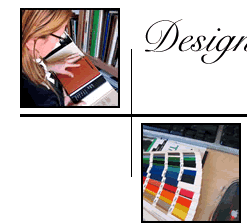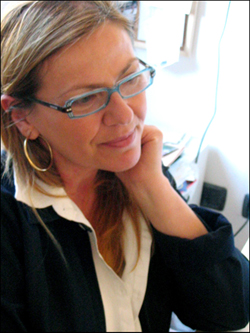 |
 |
 |
 |
 |
 |
by Melissa Schantz
In Giuseppina Dolci's career, order is a key element for success. Her office reflects this principle.
|
 |
"My work is a representation of my professionalism, so I like to keep my space and projects well organized," said Dolci, gesturing around her office and pushing a lock of light-brown hair behind her ear.

Dolci, wearing blue glasses with rhinestones emblazoned on the sides, smiles as she speaks. On her desk, layouts of graphic design are arranged neatly to the right of a computer monitor. Large bookcases positioned around the well-lit office hold rows of textbooks and application manuals for graphic programs such as Quark Express, Adobe Photoshop, Adobe Streamline, Adobe Acrobat and Adobe Illustrator.
A book about the Adriatic Sea, Adriatico, Cultura arti del Mare lies on the desk, opened to a page of Dolci's graphic design. Sitting in her office chair, Dolci points to a paper displaying cartoon-like images of an apple core, rusty tin can, worn leather armchair and old newspaper. These images line the cover of a brochure with the name of a recycling company, Natura. Window light illuminates the array of color splashed throughout the office. The multitude of shades accents Dolci's vibrant personality as she enthusiastically discusses her work. |
|
|
Natura has recently commissioned Dolci for the graphic design of a campaign promoting recycling awareness. Italian law states that each town must recycle at least 38 percent of its trash, or it will be penalized with an increased tax. For this reason, Natura is working to make recycling efforts more efficient. Dolci and Natura collaborated on ideas for the campaign and developed a brochure detailing the dos and don'ts of proper recycling methods.
Dolci has been a graphic designer since 1986. She was born in the coastal town of Fano, about 29 miles from Cagli, where she now lives. Dolci was interested in graphic design from a young age. She explored her interest by enrolling in a five-year graphic arts institute for high school. For advanced training, Dolci attended a graphics and publishing institute in Urbino.
"It just sort of happened," said Dolci as she reflected on her transition from graphic school into her career as a graphic designer. |
|
 |
 |
 |
| For the most part, Dolci works alone in designing her campaigns. However, with increasing demand for her work, she has occasionally had to hire freelance graphic artists from Fano and Urbino to collaborate on her campaigns. It is not difficult for Dolci to find assistance for her work because many graphic designers live in the area. Dolci attributes some of the interest in graphic design to the freedom it allows. |
|
 |
 |
 |
 |
 |
"In Italy, advertising is very popular because there are no rules," said Dolci.
Within Italy, advertising is conducted under a system of self-regulation. As Dolci explained, an advertiser or graphic artist must adhere to the Code of Self-Regulation set forth by the non-profit organization, Istituto dell'Autodisciplina Pubblicitaria (Institute of Self-Regulatory Publishing). If an advertiser or graphic artist publishes copy or image that is controversial or violates the Code, it is up to the public to come forth to complain. Only then will the advertisement be evaluated by the Review Board of the Istituto. |
|
 |
 |
 "The images that I use in my advertisements are usually of nature or objects, and not people. For this reason, I don't usually have to question if they will be objectionable," said Dolci. "The images that I use in my advertisements are usually of nature or objects, and not people. For this reason, I don't usually have to question if they will be objectionable," said Dolci.
Dolci does remember one occasion upon which she had to question whether or not an image she used would stimulate controversy. She was commissioned to design an advertisement for air conditioning in delivery trucks. The advertisement featured a woman in a nightgown sweating in the heat because the client thought that it would appeal to its target market of truck drivers. Against Dolci's personal judgment, she used the image that the client wanted. Fortunately, no one complained about the advertisement when it was published, and Dolci was not subjected to evaluation from the Review Board.
Dolci recently moved to Cagli to live with her Cagliese boyfriend, Andre.
"I came to Cagli for love," she said. |
 In October 2005, Dolci opened her office in Cagli. "It was not difficult to move my office to Cagli because I carried my clients with me to my new office," said Dolci. "In my field, most communication is done through the Internet. This is the digital era." In October 2005, Dolci opened her office in Cagli. "It was not difficult to move my office to Cagli because I carried my clients with me to my new office," said Dolci. "In my field, most communication is done through the Internet. This is the digital era."
Even before she moved to Cagli, Dolci has relied primarily on word of mouth to advertise her services, and she said she feels that the quality of her work will attract new clients. For this reason, Dolci does not use a company Web site. She has picked up two new clients in Cagli because of positive recommendations from past clients. One of the new companies that Dolci acquired in this manner is La Macina, an environmental and education tourism company. |
|
|
Photos by Kristen Cesiro
Video by Kevin Zazzali
Web Design by Kimberly Schurtz
[HOME] |
|
|
|
| |
|
 |



